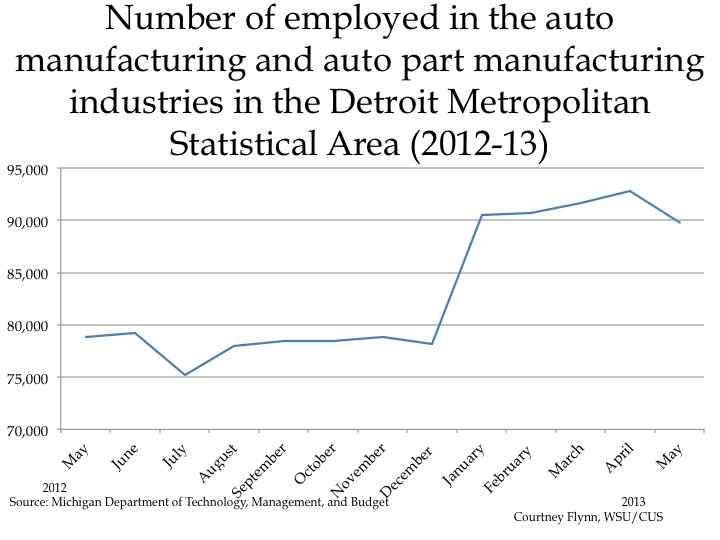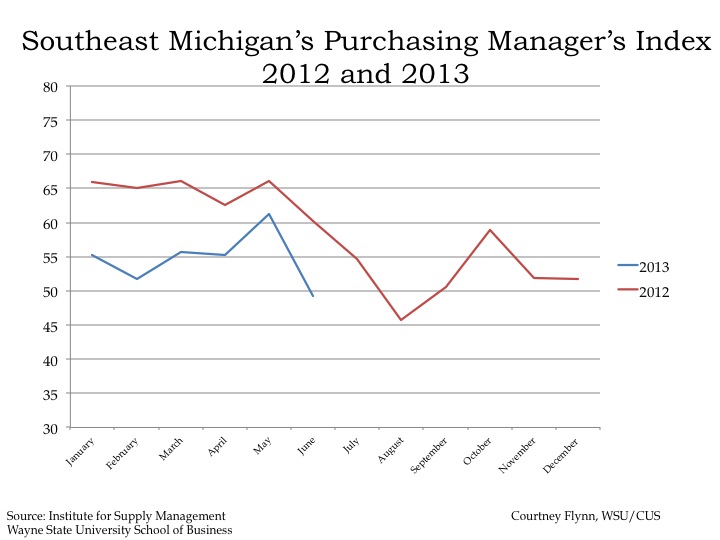According to the most recent data provided by the Michigan Department of Technology, Management and Budget, there was no change in the unemployment rate for the State of Michigan between April 2013 and May 2013; it was 8.4 per 100 people. However, for the City of Detroit, the unemployment rate rose from 16.0 in April to 16.3 in May. Despite this slight increase in Detroit’s unemployment rate for May 2013, the rate was 1.3 points below where it was in May 2012.
In May 2013 there were 283,508 people employed in the City of Detroit, an increase of about 3,000 people from April 2013. There were also about 7,000 more people employed in May 2013 than in May 2012.
The above chart shows the number of people employed in the auto and auto part manufacturing industries in the Detroit Metropolitan Statistical Area (MSA) from May 2012 to May 2013. There was an increase in the number employed in these industries from December 2012 to April 2013, but there was a slight decline between April 2013 and May 2013. In April 2013, there were 92,800 people employed in the auto and auto part manufacturing sector in the Detroit MSA, and, in May 2013, there were 89,800 people employed.
The Purchasing Manger’s Index (PMI) is a composite index derived from five indicators of economic activity: new orders, production, employment, supplier deliveries, and inventories; a PMI above 50 means the economy is expanding. According to the most recent data released on Southeast Michigan’s Purchasing Manager’s Index, there was a decline of 12 points from May 2013 to June 2013; in June, it was recorded at 49.2 . The PMI of 49.2 is reflective of the drop in the New Orders Index, Employment Index, and Finished Goods Index. The June index was the first time Southeast Michigan’s PMI had dropped below 50 since August 2012.
The Commodity Price Index, which is a weighted average of selected commodity prices, was recorded at a higher level in June 2013 compared to June 2012 for Southeast Michigan; there was a 16 point difference. In June 2013, the Commodity Price Index was reported at 59.5; this was a 7.5 point increase from May 2013.
The above charts show the Standard and Poor Case Shiller Home Price Index for the Detroit Metropolitan Statistical Area. According to the index, in Detroit, the average price of homes (single-family dwellings) sold increased by about $16,000 from June 2011 to April 2013. The index includes the price for homes that have sold but does not include the price of new home construction, condos, or homes that have been remodeled.
Like the Home Price Index, the annual percent change in the Home Price Index also showed a relatively steady increase since June 2011. Between April 2012 and April 2013, there was a 19.9 percent increase in home prices for the Detroit MSA.
The above charts show the number of residential building permits obtained each month in Oakland, Macomb, and Wayne counties from January 2012 until May 2013. These numbers are reported by local municipalities to the Southeastern Michigan Council of Governments and include single family, two family, attached condo, and multi-family units.
Of the three counties examined, Macomb County was the only county that experienced an increase in the number of permits obtained from April to May in 2013 (an increase of 95 permits). The number obtained in Wayne County decreased by 32 from April to May and the number for Oakland County decreased by 9.
When comparing the number of permits obtained in May 2012 versus May 2013 for these three counties, Macomb County was the only county to show an increase, 47 permits. There was a decrease of 2 permits for Oakland County, and, in Wayne County, the number of permits obtained remained the same.









